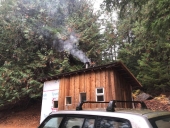M Ahmed wrote:With respect to the length of the feed/tunnel/riser... where exactly do I measure for the 1:2:4 ratio?
Is there a diagram I can refer to?
This 1:2:4 ratio was what I used while
optimizing a small J-tube, as long ago as 2011. The measurement is done in the heart of the tube, seen in stream direction. 1 is measured from the top of the feed tube to the middle of the tunnel, 2 from the middle of the feed tube to the middle of the riser, 4 from the middle of the tunnel to the top.
At the time, I tried to establish a simple formula which describes the proportions of the J-tube. The idea was to come up with an acceptable way for measuring the thing. In my humble opinion, the formula should also contain the diameter of the tube itself. Something like 1/2:1:2:4, or 1:2:4:8. In the latter row, 1 is the tube involved, 2 is the feed depth as described, 4 the tunnel length and 8 the riser height. As a side note: for larger systems the riser could be shorter than the 8 times system size. Let's say 7.5 for 6" systems and 7 for 8" systems. This is just a guess, I didn't build a larger one than 4" and no testing has been done on larger systems as a consequence.
Lots of people wanted the tunnel to be longer and the riser shorter or something else, too much opposition and a lot of noise, so the whole of the proposal was ditched. A year later I was very busy with developing the batch box rocket so the J-tube formula was banned to the back burner.
But to my surprise, just now and then it creaps up again.









